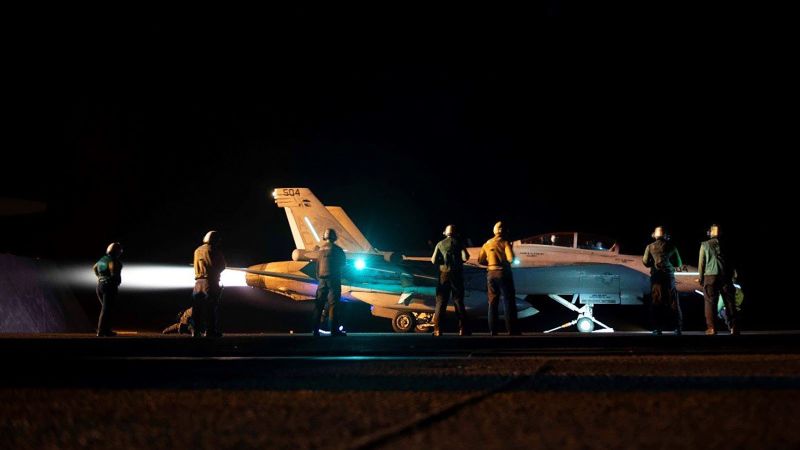CNN
—
The United States and Britain, with support from several other countries, carried out attacks on Houthi targets in Yemen from air and ground platforms, including fighter jets. At least 30 targets in at least 10 locations were attacked, two U.S. officials said.
Targets also included command and control. Underground weapons storage facility. One official said the Houthis are using other weapons to target international shipping lanes.
“While our goal remains to de-escalate tensions and restore stability to the Red Sea, we would like to reiterate our warning to the Houthi leadership: “We will not hesitate to continue to protect the free flow of commerce in the face of continuing threats,” the US and UK said in a joint statement with Australia, Bahrain, Canada, Denmark, the Netherlands and New Zealand.
Two US destroyers fired Tomahawk missiles as part of an attack on Houthi targets in Yemen, US officials told CNN. The Arleigh Burke-class guided missile destroyers USS Gravely and USS Kearney fired ground-attack cruise missiles during the operation.
F/A-18 fighter jets from the aircraft carrier USS Dwight D. Eisenhower also participated in the attack, officials said.
U.S. Central Command said early Saturday that the U.S. struck six Houthi anti-ship cruise missiles before they were launched into the Red Sea.
The daily airstrikes come as the Biden administration adopted a “layered” response to drone strikes that killed three U.S. service members and injured dozens more over the weekend.
US Central Command
The US-led coalition carried out airstrikes in Yemen in response to the Houthi offensive in the Red Sea on February 3, 2024.
Seeking to avoid a regional war with Tehran, the United States is not targeting Iran directly, but instead going after some of the region's most powerful proxies. This is an indirect way of trying to send a message to Iran's leadership, which is increasingly nervous about the actions of some of the extremist groups it supports, CNN reported. Although Iran provides varying degrees of funding, arms, and supplies to these groups, its leadership does not directly control them.
The attack in Yemen is different from the attack in Iraq or Syria. The former is a response to continued Houthi attacks on U.S. warships in international shipping lanes and the Red Sea, and the latter is in retaliation for deadly attacks on U.S. forces. But both target Iranian-backed groups in the Middle East.
U.S. Defense Secretary Lloyd Austin said the latest attacks were “aimed at further disrupting and diminishing the capabilities” of the Houthi militia.
“This collective action sends a clear message to the Houthis that they must cease their illegal attacks on international shipping and naval vessels or continue to suffer further consequences,” Austin said in a statement Saturday. Stated. “We will not hesitate to protect lives and the free flow of commerce in one of the world's most important waterways.”
President Joe Biden spoke out against Saturday's attack earlier this week, after two senior administration officials stressed to CNN that the U.S. does not want an escalation and that the attack was a direct response to Houthi actions. He said he had given the go-ahead.
Biden acknowledged last month that previous attacks against the Houthis had failed to deter the rebels, but said they would continue.
Meanwhile, Mohammed al-Bukhaiti, a top member of the Houthi political council, said in a statement on Saturday that “the bombing of many provinces in Yemen by the US-UK coalition does not change our position; we I can assure you that military operations against Israel will continue unchanged.” Continue no matter the cost until the crimes of genocide in Gaza are stopped and the siege on the population is lifted. ”
On Friday, the United States implemented another measure. Unprovoked attacks on four sites in Syria and three in Iraq hit more than 85 targets, including command and control centres, intelligence centers and weapons facilities.
“We believe the attack was successful,” National Security Council spokesman John Kirby said after the operation.
But the Biden administration has vowed to take further action against Iranian-backed groups in Iraq and Syria.
Austin said in a statement that Friday's U.S. airstrike was “the beginning of our response.” Neither the White House nor the Pentagon would telegraph exactly when the next phase of the response would occur.
US Central Command
The US-led coalition carried out airstrikes in Yemen in response to the Houthi offensive in the Red Sea on February 3, 2024.
Almost exactly 24 hours after the first US weapons hit targets in Iraq and Syria, the US carried out further strikes in Yemen.
Saturday's airstrike was the third time in recent weeks that the US and UK have attacked Houthi targets as part of a joint operation. On January 11, both armies attacked approximately 30 Houthi strongholds. Then less than two weeks later, the US and UK attacked eight more facilities.
Previous attacks targeted Houthi weapons storage facilities and radar sites in an effort to disrupt the Iranian-backed rebels' ability to attack international shipping lanes in the Red Sea and Gulf of Aden, some of the world's most important waterways. It became.
But the Houthis remain defiant, vowing to “confront with even greater resolve” what they call the US and UK “invaders” following previous US-led airstrikes. .
In addition to large-scale attacks against Houthi targets, the United States has also carried out smaller attacks against Houthi weapons. On Friday, the U.S. military struck four Houthi drones, and U.S. Central Command said they were ready to launch, posing an “imminent threat” to shipping lanes and U.S. warships. On the same day, the US military shot down eight unmanned aircraft, including a guided missile destroyer and an F/A-18 fighter jet, over the Red Sea and Gulf of Aden.
This story has been updated with additional information.
CNN's Kaanita Iyer and Priscilla Alvarez contributed to this report.


